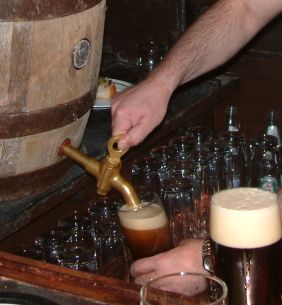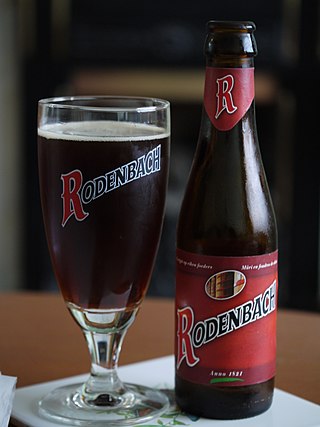
Sour beer is beer which has an intentionally acidic, tart, or sour taste. Sour beer styles include Belgian lambics and Flanders red ale and German Gose and Berliner Weisse.

Sour beer is beer which has an intentionally acidic, tart, or sour taste. Sour beer styles include Belgian lambics and Flanders red ale and German Gose and Berliner Weisse.
Unlike modern brewing, which is done in a sanitary environment to guard against the intrusion of wild yeast, [1] historically the starter used from one batch to another usually contained some wild yeast and bacteria. [2] Sours are made by intentionally allowing wild yeast strains or bacteria into the brew, traditionally through the barrels or during the cooling of the wort in a coolship open to the outside air. [3] [4]
The most common microbes used to intentionally sour beer are the bacteria Lactobacillus and Pediococcus , while the fungus Brettanomyces can also add some acidity. [1] Another method for achieving a tart flavor is adding fruit, which directly contributes organic acids such as citric acid. [4] [5] Additionally, acid can be directly added to beer or added by the use of unusually large amounts of acidulated malt.
Depending on the process employed, the uncertainty involved in using wild yeast may cause the beer to take months to ferment and potentially years to mature. [1] However, modern methods allow sour beer to be created within a typical timeframe for ales, usually several days. [6]

Making sours is a risky and specialized form of beer brewing, and longstanding breweries which produce it and other lambics often specialize in this and other Belgian-style beers. Established in 1836, one of the oldest breweries still in operation that produces sour beer is the Rodenbach Brewery of Roeselare, Belgium. [7] Sour beer has also spread outside Belgium, to other European countries, the United States and Canada.
In the United Kingdom sour ales are produced by a few different breweries, including - Thirsty Pioneers Brewing Company, Crafty Devil Brewing, Elgood's, Wild Beer Co, Brewdog Overworks, Docks Beers, Mills Brewing, Shindigger, Vault City Brewing, Yonder Brewing, Goodh, and Bundobust (in house) Brewery
While any type of beer may be soured, most follow traditional or standardized guidelines.
Beers brewed in the United States utilize yeast and bacteria strains instead of or in addition to standard brewers yeasts. These microflora may be cultured or acquired spontaneously, and the beer may be fermented in a number of different types of brewing vessels. American wild ales tend not to have specific parameters or guidelines stylistically, but instead simply refer to the use of unusual yeasts.
At one time the most popular alcoholic beverage in Berlin, this is a somewhat weaker (usually around 3% abv) beer made sour by use of Lactobacillus bacteria. This type of beer is usually served with flavored syrups to balance the tart flavor. [8]
Flanders red ales are fermented with brewers yeast, then placed into oak barrels to age and mature. Usually, the mature beer is blended with younger beer to adjust the taste for consistency. This is also sometimes referred to as "flemish red". [9]
Gose is a top-fermenting beer that originated in Goslar, Germany. This style is characterized by the use of coriander and salt and is made sour by inoculating the wort with lactic acid bacteria before primary fermentation.
Lambic is a spontaneously-fermented beer made in the Pajottenland region around Brussels, Belgium. Wort is left to cool overnight in the koelschip where it is exposed to the open air during the winter and spring, and placed into barrels to ferment and mature. Most lambics are blends of several seasons’ batches, such as gueuze, or are secondarily fermented with fruits, such as kriek and framboise. As such, pure unblended lambic is quite rare, and few bottled examples exist.
Originating from the Flemish region of Belgium, oud bruins are differentiated from the Flanders red ale in that they are darker in color and not aged on wood. As such this style tends to use cultured yeasts to impart its sour notes.

Wheat beer is a top-fermented beer which is brewed with a large proportion of wheat relative to the amount of malted barley. The two main varieties are German Weizenbier and Belgian witbier; other types include Lambic, Berliner Weisse, and Gose.

Lambic is a type of beer brewed in the Pajottenland region of Belgium southwest of Brussels and in Brussels itself since the 13th century. Types of lambic beer include gueuze, kriek lambic, and framboise. Lambic differs from most other beers in that it is fermented through exposure to wild yeasts and bacteria native to the Zenne valley, as opposed to exposure to carefully cultivated strains of brewer's yeast. This process gives the beer its distinctive flavour: dry, vinous, and cidery, often with a tart aftertaste.

Brettanomyces is a non-spore forming genus of yeast in the family Saccharomycetaceae, and is often colloquially referred to as "Brett". The genus name Dekkera is used interchangeably with Brettanomyces, as it describes the teleomorph or spore forming form of the yeast, but is considered deprecated under the one fungus, one name change. The cellular morphology of the yeast can vary from ovoid to long "sausage" shaped cells. The yeast is acidogenic, and when grown on glucose rich media under aerobic conditions, produces large amounts of acetic acid. Brettanomyces is important to both the brewing and wine industries due to the sensory compounds it produces.

Framboise is a Belgian lambic beer fermented with raspberry.

Rodenbach is a brewery in Roeselare, Belgium, now owned by Palm Breweries. It is noted for its barrel-aged sour beers in the Flemish red style.

Gose is a warm fermented beer that originated in Goslar, Germany. It is usually brewed with at least 50% of the grain bill being malted wheat. Dominant flavours in gose include a lemon sourness, a herbal characteristic, and a strong saltiness. Gose beers typically do not have prominent hop bitterness, flavours, or aroma. The beers typically have a moderate alcohol content of 4 to 5% ABV.

Victory Brewing Company (Victory) is a brewery founded in 1996 in Downingtown, Pennsylvania, United States. The main brands are HopDevil, Prima Pils, Headwaters Pale Ale, Golden Monkey, DirtWolf, and Storm King, which are distributed in 34 states and nine countries. Victory Brewing is located at 420 Acorn Lane Downingtown, Pennsylvania 19335.

Beer in Belgium includes pale ales, lambics, Flemish red ales, sour brown ales, strong ales and stouts. In 2018, there were 304 breweries in Belgium, including international companies, such as AB InBev, and traditional breweries, such as Trappist monasteries. On average, Belgians drink 68 litres of beer each year, down from around 200 each year in 1900. Most beers are bought or served in bottles, rather than cans, and almost every beer has its own branded, sometimes uniquely shaped, glass. In 2016, UNESCO inscribed Belgian beer culture on their list of the intangible cultural heritage of humanity.

Allagash Brewing Company is a brewery in Portland, Maine. The brewery specializes in Belgian style beers.

Brewery Ommegang is a brewery located near Cooperstown, New York, United States, that specializes in Belgian-style ales.

Oud Bruin, also known as Flanders Brown, is a style of beer originating from the Flemish region of Belgium. The Dutch name refers to the long aging process, up to a year. It undergoes a secondary fermentation, which takes several weeks to a month, and is followed by bottle aging for several more months. The extended aging allows residual yeast and bacteria to develop a sour flavor characteristic for this style. Usually, cultured yeast and bacteria are used, as stainless steel equipment does not harbor wild organisms as wood does.

Beer styles differentiate and categorise beers by colour, flavour, strength, ingredients, production method, recipe, history, or origin.

Brettanomyces bruxellensis is a yeast associated with the Senne valley near Brussels, Belgium. Despite its Latin species name, B. bruxellensis is found all over the globe. In the wild, it is often found on the skins of fruit.

Captain Lawrence Brewing Company is a craft brewery located in Elmsford, New York. The brewery is owned and run by head brewer Scott Vaccaro. Vaccaro, a homebrewer since 1995, trained in brewing science at UC Davis.

Flanders red ale or Flemish red-brown, is a style of sour ale brewed in West Flanders, Belgium.

American wild ale is a sour beer brewed in the United States using yeast or bacteria in addition to Saccharomyces cerevisiae for fermentation. Such beers are similar to Belgian Lambic and Oud bruin, and typically fermented using a strain of brettanomyces, resulting in a "funky" flavor.
Beer is produced through steeping a sugar source in water and then fermenting with yeast. Brewing has taken place since around the 6th millennium BC, and archeological evidence suggests that this technique was used in ancient Egypt. Descriptions of various beer recipes can be found in Sumerian writings, some of the oldest known writing of any sort. Brewing is done in a brewery by a brewer, and the brewing industry is part of most western economies. In 19th century Britain, technological discoveries and improvements such as Burtonisation and the Burton Union system significantly changed beer brewing.
A seasonal beer is a beer that is typically brewed during or for a particular season, holiday or festival period. Many breweries produce seasonal beers. Seasonal beers may be produced when fresh ingredients are available during various seasons, per climatic conditions during the time of the year, and also as a tradition. Furthermore, seasonal beer is produced based upon seasons, holidays, festivals and events.

Ale is a type of beer, brewed using a warm fermentation method. In medieval England, the term referred to a drink brewed without hops.

A barrel-aged beer is a beer that has been aged for a period of time in a wooden barrel. Typically, these barrels once housed bourbon, whisky, wine, or, to a lesser extent, brandy, sherry, or port. There is a particular tradition of barrel ageing beer in Belgium, notably of lambic beers. The first bourbon barrel-aged beers were produced in the United States in the early 1990s.